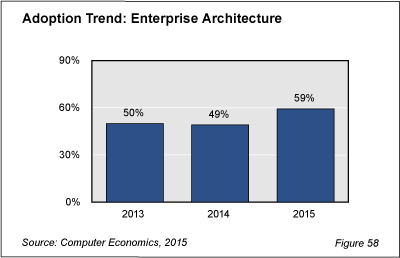The Computer Economics annual IT Management Best Practices study finds that enterprise architecture has become one of the fastest-rising practices in IT organizations today.
As shown in Figure 58 from the study, 59% of IT organizations currently engage in the practice of enterprise architecture, which is up from 49% a year earlier. That represents a 21% increase in adoption of this practice, which is the sharpest rise of any of the 33 practices in the study.

Enterprise architecture is touted by proponents as a means of helping transform businesses into agile, digital businesses by reigning in chaotic IT infrastructures. Critics, however, maintain most EA plans end up as shelfware or worse, they can stifle innovation.
“It appears the jury is in,” said John Longwell, vice president of research for Computer Economics, Irvine, Calif. “Organizations today are under pressure to transform their IT infrastructures to take advantage of the digital enterprise and they can no longer afford to just keep patching legacy systems.”
The practice is one of 33 profiled in the IT Management Best Practices 2015-2016 study. The study, now in its eleventh year, analyzes the adoption rates, practice level, and growth trend for each practice. The practices in the study are as follows:
-
IT governance practices: IT strategic planning, IT executive committee, IT project portfolio management, and IT change control board
-
IT financial management practices: IT personnel cost accounting, IT service cost accounting, IT chargeback, showing back of IT expenses, IT service catalog, and benchmarking IT spending
-
IT operational management practices: IT policies and procedures, enterprise architecture, IT Infrastructure Library (ITIL), project management office (PMO), IT asset management system, BYOD policy, post-implementation audits, user satisfaction surveying, and publishing IT performance metrics
-
IT security and risk management practices: Formal security policies, auditing compliance with IT security policies, data classification, security incident management, disaster recovery planning, testing of disaster recovery plan, business continuity planning
- Software development practices: System development life cycle, agile software development, peer reviews, automated testing, change management, and software metrics, DevOps methodology
This study is designed to increase the awareness of IT leaders concerning what are best practices in IT management, provide benchmarks against which an IT organization can compare its own adoption and practice level, and justify investments to improve an organization’s IT management practices.
This Research Byte is a brief overview of our report on this subject, IT Management Best Practices 2015-2016. The full report is available at no charge for Computer Economics clients, or it may be purchased by non-clients directly from our website (click for pricing).

